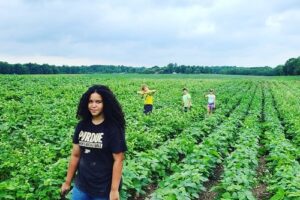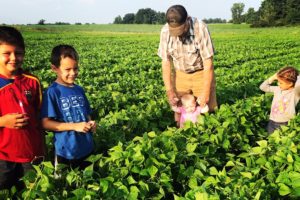Perhaps, it was the swamp verbena blooming much too early on that old familiar trail. Or more likely, the steady, mild weather that replaced a more ‘typical,’ Michigan cold season (aside from the Polar Vortex in January 2024). Looking back, the winter of 2023-24 felt more like a persistent fall with occasional quickly melting snow than the Michigan winters of yesteryear. My ‘canary in a coal mine’ moment came when I noticed the swamp verbena’s early bloom, prompting me to confirm with data what my intuition had been sensing about this year’s atypical weather and growing season. Friends, things feel different because they are different.


The saying ‘canary in a coal mine’ is often used in a synonymous way as an early warning sign of danger. The metaphor originates from the historical (and literal) practice of coal miners bringing caged canaries into coal mines to detect toxic gases like carbon monoxide. Canaries, being more sensitive to these gases, would show signs of distress before the levels became hazardous to humans, thus alerting the miners to the presence of danger. Note: The canary was employed until 1986. While I don’t aim to be alarmist, I’ve been monitoring insect foraging on plants for nearly 20 years and significant changes are occurring.

We entered November 2023 with 18 honey bee colonies, and by early June 2024 the apiary had ballooned to 44 hives. The spring’s energy – warmth, pollen, nectar, and days of flight – led to a more powerful and explosive bee population build-up than ever seen from February to early May. As I write this in mid-July, two things are clear: the honey bee populations grew and expanded more than ever this spring, and there is less excess honey available to harvest than ever before.
Early this spring, we witnessed significant pollen entering colonies earlier than the last 10 years of detailed records. An unusual and heavy honey flow abruptly halted in late May. At one point, I noted in my bee journal, ‘What will we do with all this honey if it keeps coming in this way?’ However, the nectar flow did not return for nearly the entire month of June, which is on average a significant honey month. Here in southwest Michigan, peak nectar flow often occurs in June and July, coinciding with the blooming of many plants including clover, basswood, alfalfa, and various garden plants. Typically, this is when we add supers (honey boxes) to manage honey storage, and by early July, we harvest our first large pull of honey. Not so this year. In fact, the only excess honey we harvested was from May.



With all signs pointing to major seasonal shifts, I knew it was time to run the degree day accumulation data to draw comparisons from this season to previous years. MSU’s Enviroweather and Pierce Cedar Creek Institute (just down the road from our farm) provided reliable historical weather data. Growing degree days (GDD) measure heat accumulation to predict plant and insect development rates. They are calculated by averaging daily maximum and minimum temperatures and subtracting a base temperature (here, I used base 32°F and 50°F). GDDs help farmers and gardeners estimate when a crop will reach a certain stage of growth, allowing for better planning and management of planting, harvesting, and pest control activities.
Based on growing degree day accumulations (from Jan 1 to Jul 2) we are about two weeks ahead of last year (see table below), and nearly 500 DD above the 10-year average. A significant challenge for plants and animals (as observed with the bees and nectar resources) is that many plants begin growing at a lower base temperature (e.g., 32°F) than many insects (e.g., 50°F), leading to a disruption in seasonal timing and overlap. While we are still in the early summer stage of the bee season, early reports from beekeepers in our area mention lower than usual honey production. Additionally, increased precipitation has made flight conditions for honey bees less than optimal.


As we look ahead to August and September, we know from previous years that nectar flow often starts to decline, with late-blooming plants like goldenrod and asters providing the last major carbohydrate burst. While I cannot predict the future, I wouldn’t be surprised if we see goldenrod blooming before the end of July this year. Late summer is marked by the final honey harvests and ensuring sufficient food stores for winter. My heart and mind fill with wonder and hope. I wonder if the bees will have enough resources to get through not just the winter but the seemingly warmer, extended autumns with limited floral sources. Meanwhile, I hope for the goldenrod and asters to be the most brilliant nectar sources we’ve ever seen. And perhaps, I hold onto the practical desire that another resource will emerge to fill the ever-persistent gaps that continue to emerge as our planet warms.






Leave a Reply
Your email is safe with us.